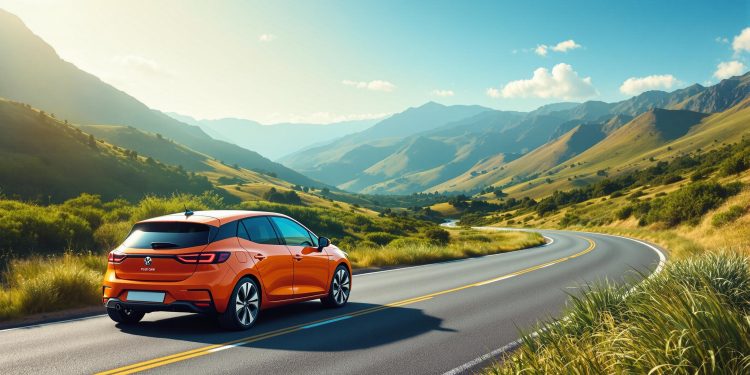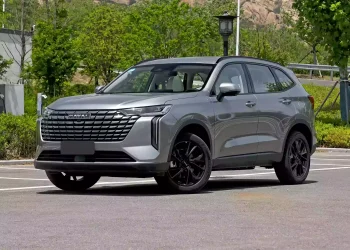Feeling the squeeze of high fuel prices in South Africa? With transportation eating up 18-22% of household budgets, saving on fuel has never been more important. Here’s how you can cut costs by up to 40%:
- Drive Smart: Gentle acceleration, steady speeds, and reducing idling can save 15-30%.
- Maintain Your Car: Proper tyre pressure, regular servicing, and clean air filters improve efficiency.
- Plan Routes Better: Avoid traffic, combine errands, and minimize short trips to save time and fuel.
- Lighten Your Load: Remove unused items and roof racks to reduce weight and drag.
- Think Long-Term: Carpool, consider fuel-efficient vehicles, or even hybrids for sustained savings.
These easy changes can add up to significant monthly savings. Start with small adjustments like smoother driving and regular maintenance to see immediate results.
How to save money on fuel in any car – 10 fuel saving tips
1. Smart Driving Methods
You can cut down on fuel use significantly by adopting smarter driving habits – no need for costly vehicle upgrades. These tips focus on how you drive and respond to traffic, and they pair well with vehicle maintenance strategies.
Gentle Acceleration and Braking
Driving aggressively – like speeding or braking hard – can increase fuel consumption by 30-40% in stop-and-go traffic, which is common in cities like Johannesburg [5][8]. Instead, aim for smooth, gradual movements.
Try accelerating to 20 km/h over five seconds while keeping your engine below 2,500 RPM for petrol vehicles [8][1]. A helpful trick? Imagine balancing a full coffee cup on your dashboard to keep your acceleration smooth [8].
"Aggressive driving (speeding/rapid acceleration) can lower highway gas mileage by 15-30% at highway speeds" – Mobil Fuel Efficiency Guide [2]
Steady Speed Driving
Fuel efficiency peaks between 50-90 km/h, with 80 km/h being the sweet spot for most sedans [5][2][1]. Stick to steady speeds to maximize mileage.
On highways, using cruise control at speeds under 100 km/h can save you 7-14% on fuel [1][2].
| Speed Range | Fuel Efficiency Impact | Best Use Case |
|---|---|---|
| 80-90 km/h | Peak efficiency | Highways |
| Below 100 km/h | 15% more efficient | Long-distance travel |
Reduce Engine Idling
Extended idling wastes fuel, and modern cars don’t need long warm-up times. The Automobile Association of South Africa suggests turning off your engine if you’re stationary for:
- More than 30 seconds at traffic lights
- Over a minute in drive-through lines
- Longer loading or unloading times [1][4]
This habit is especially useful in school zones, during Gauteng highway congestion, or amid seasonal roadworks [4][9].
An idling engine burns about 3.7 liters of fuel per hour in typical sedans [7]. For urban drivers frequently stuck in traffic, cutting idle time can lead to noticeable fuel savings.
2. Regular Car Maintenance
Keeping up with regular car maintenance not only supports fuel-saving habits but also helps cut long-term costs. For instance, as mentioned earlier, proper maintenance can contribute to the R4,800-R6,000 savings example. When combined with smart driving techniques, the benefits really add up.
Correct Tyre Pressure
Checking your tyre pressure every month is a quick and effective way to improve fuel efficiency. You can find the recommended pressure for your vehicle on the sticker located on the driver’s door jamb [1][4]. This check only takes a couple of minutes at the fuel station and pairs well with reducing idling time at traffic lights (from Tip 1) for even more savings.
| Tyre Condition | Fuel Impact | Suggested Action |
|---|---|---|
| Underinflated | Increases usage by 10% | Check monthly |
| Poor Alignment | Increases usage by 5% | Align every 20,000 km |
Engine Maintenance Schedule
Stick to the service intervals recommended by your car’s manufacturer. For example, Toyota advises a 10,000 km service cycle in harsher conditions [6]. Also, ensure you’re using the correct oil viscosity, as using the wrong type can reduce fuel efficiency by 1-2% [3].
Clean Air Filters
While modern fuel-injected engines are less affected by dirty air filters (with only a 1-2% efficiency drop), keeping them clean is still important for overall performance [3]. In South Africa’s dusty regions, like Gauteng, air filters should be replaced every 10,000-15,000 km, especially in high-dust areas.
Replacing an air filter costs between R200 and R500 but can lead to up to 18% in fuel savings when paired with other proper maintenance practices [1][3][6].
3. Better Route Planning
Smart navigation choices play a big role in cutting down fuel costs, especially in South Africa’s bustling cities. By planning routes wisely, you can save both time and money.
Multi-Stop Trip Planning
Planning trips with multiple stops can save a lot on fuel – up to 15-20% compared to making several separate trips [1][4]. Tools like Waze’s "Planned Drives" or Google Maps’ multi-stop feature help organize stops in a way that minimizes driving distance and time. For example, urban trials showed a 22% fuel saving when stops were sequenced efficiently [7].
Avoiding Traffic Jams
Sitting in traffic isn’t just frustrating – it also burns more fuel. Stop-and-go driving in heavy congestion can increase fuel consumption by 30-40% [5]. Navigation apps like Waze can suggest alternate routes in real-time to dodge traffic. In Cape Town, drivers who used Waze during rush hour saved about 18% more fuel compared to those sticking to standard GPS directions [1][5].
To get the most out of these tools, check traffic predictions before heading out. This way, you can avoid getting stuck in gridlock altogether.
Cutting Down on Short Car Trips
Short drives, especially those under 2km, use 20-25% more fuel per kilometer because of cold engine operation [1][8]. In humid areas like Durban, running the AC during these trips can bump fuel consumption up by another 15% [4].
For these short trips, consider alternatives like:
- Walking or using delivery options.
- Combining short errands with longer drives to make fewer trips.
- Parking in a way that reduces the need for engine warm-up, which can save up to 15% on fuel [4].
These strategies not only save fuel but also pair well with upcoming tips on reducing vehicle weight.
sbb-itb-09752ea
4. Lower Car Weight and Air Resistance
After refining your routes (Tip 3), it’s time to look at your vehicle’s performance. Two key factors – weight and aerodynamics – can significantly affect fuel consumption.
Lighten Your Load
Carrying extra weight? It’s costing you. For every additional 100kg, fuel usage jumps by 4-8% [1][4]. This is especially noticeable in stop-and-go city driving or on hilly roads.
Think about what’s in your car. Items like unused sports gear, unnecessary emergency kits, forgotten tools, or child seats you don’t need could be draining your wallet. Regularly clearing out your car’s boot can make a difference. For example, removing 50kg could save you R150-R300 per month if you drive 15,000km annually [1][4].
The Automobile Association (AA) advises:
"Pack lightly, and remember to remove unused heavy items like bike racks or roof racks from your car when not in use." [1]
Ditch Unused Roof Racks
Roof racks might be handy, but if they’re empty, they’re working against you. At highway speeds, they can increase wind resistance, leading to a 2-8% hike in fuel consumption. The faster you go – especially over 80km/h – the worse it gets.
| Storage Type | Fuel Efficiency Impact | Monthly Cost Impact* |
|---|---|---|
| Empty Roof Rack | 2-8% decrease | R400-R600 |
| Closed Roof Box | 2-5% decrease | R200-R300 |
| Trunk Storage | Minimal impact | Negligible |
| Based on highway commutes [1][4] |
When should you remove roof racks? If you haven’t used them in over two weeks or don’t plan on hauling cargo for trips longer than 50km, it’s time to take them off. For occasional use, consider removable racks or switch to hitch-mounted carriers for items like bicycles [1][4].
These small changes can lead to noticeable savings and set you up for broader strategies, such as carpooling or upgrading your vehicle (Tip 5).
5. Long-Term Fuel Cost Reduction
Building on short-term strategies like reducing vehicle weight, these methods can help you save on fuel over the long haul:
Share Rides and Split Costs
Carpooling is a practical way to cut fuel expenses while also reducing traffic. Research shows that structured carpool setups with fixed schedules can lower commuting costs by 20-30% [10]. Combine ride-sharing with multi-stop routing (as mentioned in Tip 3) to get even more out of this approach.
"(Total distance × current fuel price) ÷ (vehicle fuel efficiency × number of passengers)" [1]
Popular options include Lift Club SA for long-distance commutes, Go!Durban for corporate ride-sharing, and even local WhatsApp groups for school runs.
Opt for a Fuel-Efficient Vehicle
If you’re in the market for a new car, think about how fuel-efficient it is over the long term. Hybrid vehicles, for example, can be a great choice for South African conditions [3][8].
Here are some key features to look for in a fuel-efficient car:
- Compact engines (under 1600cc)
- Good power-to-weight ratio for handling hills
- Aerodynamic design to reduce drag
For those considering electric vehicles (EVs), keep these South African-specific factors in mind:
- Charging during off-peak hours can lower costs in major cities.
- EVs generally have fewer maintenance needs since they don’t require oil changes.
- Plan for battery capacity that suits local climate and driving conditions [3][11].
In some areas, like the Western Cape, EV owners can benefit from reduced registration fees [2][8]. Plus, there are rebates available for hybrids assembled locally that meet emissions standards [3][12].
Before committing to a new vehicle, check real-world fuel consumption figures. Some newer engines may not perform as well at higher altitudes compared to older models [4].
Conclusion: Put These Tips into Practice
By applying these strategies regularly, you could cut your monthly fuel costs by 25-40%. As shown in the earlier example, using these methods together offers the best results over time.
Start with the easiest changes, like accelerating gently and clearing out unnecessary items from your car. These steps don’t cost a cent and can deliver quick savings. Pair these actions with regular maintenance (like checking tire pressure and replacing filters) for even better results.
Keep track of your fuel expenses using your car’s onboard computer. Combine this with smarter navigation techniques to get the most out of every liter of fuel.
Here’s a simple 30-day plan to get started:
- Week 1: Focus on smooth driving habits and decluttering your car.
- Week 2: Check tire pressure and replace air filters as needed.
- Week 3: Use traffic-avoidance tools and plan trips more efficiently.
- Week 4: Look into carpool options and consider fuel-efficient vehicle models.
During Week Two, align your maintenance efforts with the potential savings of R4,800-R6,000 mentioned earlier. This step-by-step approach helps you build lasting habits while improving your car’s fuel efficiency.
For updates on fuel-saving technologies and local fuel prices, follow ImotoNews South Africa.
FAQs
How do I reduce my car’s fuel consumption?
Here are some practical tips to help you cut down on fuel usage:
When should I turn off my engine in traffic?
The AA South Africa recommends turning off your engine if you’re idling for more than 30 seconds [1]. This tip is especially handy during heavy traffic, like the congestion seen on Gauteng highways.
How does driving style affect fuel use?
Maintaining a steady speed under 90 km/h and avoiding sudden acceleration can lower fuel consumption by 25–40% [2][8]. Smooth, consistent driving makes a big difference.
Does air conditioning really affect fuel consumption?
Yes, it does. Here’s how to minimize its impact:
- Set the AC to 22°C instead of max cooling.
- Use natural ventilation when driving under 60 km/h.
These small changes can save 4–7% on fuel costs [4]. Pair this with proper route planning and lighter vehicle loads for even better results.
What about tire pressure?
Check your tire pressure monthly, preferably when the tires are cold. Use the recommended levels provided on your driver’s door jamb. Properly inflated tires can significantly boost your car’s efficiency [2].
Related Blog Posts
- Factors That Influence Used Car Prices in South Africa
- Fuel-Saving Tips for Long South African Road Trips
- Top 5 Cars for South African Roads
- 7 Winter Car Care Tips for South Africa





